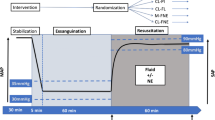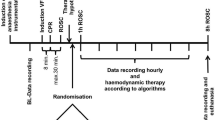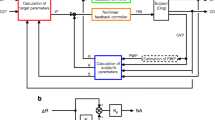Abstract
We evaluated the performance of a new device to control the administration of fluid alone or co-administration of fluid and norepinephrine in a pig model of haemorrhagic shock in two sets of experiments. In the first one, resuscitation was guided using continuous arterial pressure measurements (three groups: resuscitation with fluid by a physician, CL resuscitation with fluid, and CL resuscitation with fluid and norepinephrine). In the second one, resuscitation was guided using discontinuous arterial pressure measurements (three groups: CL resuscitation with fluid alone, CL resuscitation with fluid and moderate dose norepinephrine, and CL resuscitation with fluid and a high dose of norepinephrine). Pigs were resuscitated for 1 h. In the first set of experiments, proportion of time spent in the target area of 78–88 mmHg of systolic arterial pressure was not statistically different between the three groups: manual, 71.2% (39.1–80.1); CL with fluid, 87.8% (68.3–97.4); and CL with fluid and norepinephrine, 78.1% (59.2–83.6), p = 0.151. In the second set of experiments, performance of CL resuscitation with fluid or with combination of fluid and high or moderate dose of norepinephrine was not significantly different (p = 0.543 for time in target). Pigs resuscitated with norepinephrine required less fluid and had less haemodilution than pigs resuscitated with fluid alone. Performance of CL resuscitation using continuous arterial pressure measurement was not significantly different than optimised manual treatment by a dedicated physician. Performance of CL resuscitation was reduced with discontinuous arterial pressure measurements in comparison with continuous arterial pressure measurements.



Similar content being viewed by others
References
Rossaint R, Bouillon B, Cerny V, Coats TJ, Duranteau J, Fernandez-Mondejar E, et al. The European guideline on management of major bleeding and coagulopathy following trauma: fourth edition. Crit Care. 2016;20:100.
Kramer GC, Kinsky MP, Prough DS, Salinas J, Sondeen JL, Hazel-Scerbo ML, et al. Closed-loop control of fluid therapy for treatment of hypovolemia. J Trauma. 2008;64(4 Suppl):S333–S34141.
Salinas J, Chung KK, Mann EA, Cancio LC, Kramer GC, Serio-Melvin ML, et al. Computerized decision support system improves fluid resuscitation following severe burns: an original study. Crit Care Med. 2011;39(9):2031–8.
Ying H, Bonnerup C, Kirschner R, Deyo D, Michell M, Kramer G (2002) (eds) Closed-loop fuzzy control of resuscitation of hemorrhagic shock in sheep. Engineering in Medicine and Biology, 2002 24th Annual Conference and the Annual Fall Meeting of the Biomedical Engineering Society EMBS/BMES Conference, 2002 Proceedings of the Second Joint; 2002: IEEE.
Joosten A, Alexander B, Duranteau J, Taccone FS, Creteur J, Vincent JL, et al. Feasibility of closed-loop titration of norepinephrine infusion in patients undergoing moderate- and high-risk surgery. Br J Anaesth. 2019;123(4):430–8.
Joosten A, Delaporte A, Alexander B, Su F, Creteur J, Vincent JL, et al. Automated titration of vasopressor infusion using a closed-loop controller: in vivo feasibility study using a swine model. Anesthesiology. 2019;130(3):394–403.
Rinehart J, Joosten A, Ma M, Calderon MD, Cannesson M. Closed-loop vasopressor control: in-silico study of robustness against pharmacodynamic variability. J Clin Monit Comput. 2019;33(5):795–802.
Rinehart J, Lee C, Canales C, Kong A, Kain Z, Cannesson M. Closed-loop fluid administration compared to anesthesiologist management for hemodynamic optimization and resuscitation during surgery: an in vivo study. Anesth Analg. 2013;117(5):1119–29.
Marques NR, Whitehead WE, Kallu UR, Kinsky MP, Funston JS, Wassar T, et al. Physician-directed versus computerized closed-loop control of blood pressure using phenylephrine in a Swine model. Anesth Analg. 2017;125(1):110–6.
Michard F, Alaya S, Zarka V, Bahloul M, Richard C, Teboul JL. Global end-diastolic volume as an indicator of cardiac preload in patients with septic shock. Chest. 2003;124(5):1900–8.
Hofer CK, Furrer L, Matter-Ensner S, Maloigne M, Klaghofer R, Genoni M, et al. Volumetric preload measurement by thermodilution: a comparison with transoesophageal echocardiography. Br J Anaesth. 2005;94(6):748–55.
Wiggers CJ. The present status of the shock problem. Physiol Rev. 1942;22:74–123.
Daye P, Ieng SH, Benosman R. A Theory for sparse event-based closed loop control. Front Neurosci. 2019;13:827.
Libert N, Chenegros G, Harrois A, Baudry N, Cordurie G, Benosman R, et al. Performance of closed-loop resuscitation of haemorrhagic shock with fluid alone or in combination with norepinephrine: an experimental study. Ann Intensive Care. 2018;8(1):89.
Chaisson NF, Kirschner RA, Deyo DJ, Lopez JA, Prough DS, Kramer GC. Near-infrared spectroscopy-guided closed-loop resuscitation of hemorrhage. J Trauma. 2003;54(5 Suppl):S183–S192192.
Rafie AD, Rath PA, Michell MW, Kirschner RA, Deyo DJ, Prough DS, et al. Hypotensive resuscitation of multiple hemorrhages using crystalloid and colloids. Shock. 2004;22(3):262–9.
Do Nascimento P Jr, Vaid SU, Hoskins SL, Espana JM, Kinsky MP, Kramer GC. Hypertonic 15% sodium pyruvate offers no initial resuscitation advantage compared with 8% hypertonic NACl in sheep with multiple hemorrhages. Shock. 2007;27(5):565–71.
Vaid SU, Shah A, Michell MW, Rafie AD, Deyo DJ, Prough DS, et al. Normotensive and hypotensive closed-loop resuscitation using 3.0% NaCl to treat multiple hemorrhages in sheep. Crit Care Med. 2006;34(4):1185–92.
Marques NR, Ford BJ, Khan MN, Kinsky M, Deyo DJ, Mileski WJ, et al. Automated closed-loop resuscitation of multiple hemorrhages: a comparison between fuzzy logic and decision table controllers in a sheep model. Disaster Mil Med. 2017;3:1.
Varvel JR, Donoho DL, Shafer SL. Measuring the predictive performance of computer-controlled infusion pumps. J Pharmacokinet Biopharm. 1992;20(1):63–94.
Sng BL, Wang H, Assam PN, Sia AT. Assessment of an updated double-vasopressor automated system using Nexfin for the maintenance of haemodynamic stability to improve peri-operative outcome during spinal anaesthesia for caesarean section. Anaesthesia. 2015;70(6):691–8.
Ngan Kee WD, Khaw KS, Tam YH, Ng FF, Lee SW. Performance of a closed-loop feedback computer-controlled infusion system for maintaining blood pressure during spinal anaesthesia for caesarean section: a randomized controlled comparison of norepinephrine versus phenylephrine. J Clin Monit Comput. 2017;31(3):617–23.
Ngan Kee WD, Tam YH, Khaw KS, Ng FF, Critchley LA, Karmakar MK. Closed-loop feedback computer-controlled infusion of phenylephrine for maintaining blood pressure during spinal anaesthesia for caesarean section: a preliminary descriptive study. Anaesthesia. 2007;62(12):1251–6.
Kashihara K, Kawada T, Uemura K, Sugimachi M, Sunagawa K. Adaptive predictive control of arterial blood pressure based on a neural network during acute hypotension. Ann Biomed Eng. 2004;32(10):1365–83.
Uemura K, Kawada T, Zheng C, Li M, Sugimachi M. Computer-controlled closed-loop drug infusion system for automated hemodynamic resuscitation in endotoxin-induced shock. BMC Anesthesiol. 2017;17(1):145.
Funding
This work was supported by a grant from Mission innovation participative, Direction Générale de l’Armement, Ministère de la défense, France. https://www.defense.gouv.fr/dga/liens/mission-innovation-participative. A grant from BIOMEDEF, Direction Générale de l’Armement, Ministère de la défense, France. The funding body had no role in the design of the study and collection, analysis, and interpretation of data and in writing the manuscript.
Author information
Authors and Affiliations
Contributions
NL, AH, EV and JD designed the study. NL, GC, GC and RB designed the closed-loop device. NL, NB, BD, OM and GC conducted the study and collected the data. NL, AH, EV and JD analyzed the data. NL, GC, AH, EV and JD prepared the manuscript. All authors critically reviewed and approved the final manuscript.
Corresponding author
Ethics declarations
Conflict of interest
NL has received research grants from Mission innovation participative, Direction Générale de l’Armement, Ministère de la défense, France and BIOMEDEF, Direction Générale de l’Armement, Ministère de la défense, France.
Research involving Animals
All the procedures performed in studies involving animals were in accordance with the ethical standards of the institution or practice at which the studies were conducted (Institutional animal committee:Comité d'Ethique en Expérimentation Animale Capsud n°26). All procedures were reviewed and approved by the institutional animal committee and by the French national ethical committee (APAFIS authorisation number: #3918-2016020213092528). This manuscript adheres to the ARRIVE (Animal Research: Reporting of In Vivo Experiments) guidelines for reporting animal research.
Informed consent
Not applicable.
Additional information
Publisher's Note
Springer Nature remains neutral with regard to jurisdictional claims in published maps and institutional affiliations.
Electronic supplementary material
Below is the link to the electronic supplementary material.
Rights and permissions
About this article
Cite this article
Libert, N., Chenegros, G., Harrois, A. et al. Performance of closed-loop resuscitation in a pig model of haemorrhagic shock with fluid alone or in combination with norepinephrine, a pilot study. J Clin Monit Comput 35, 835–847 (2021). https://doi.org/10.1007/s10877-020-00542-7
Received:
Accepted:
Published:
Issue Date:
DOI: https://doi.org/10.1007/s10877-020-00542-7




